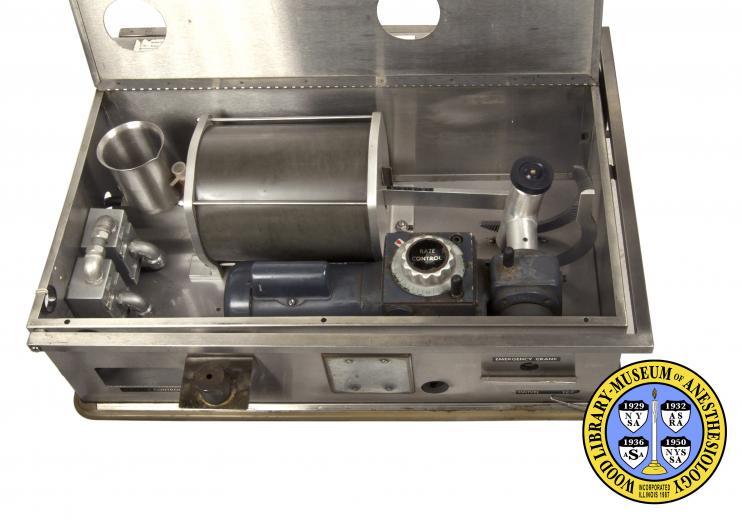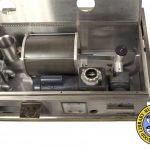Mueller-Morch Piston Respirator
Dr. Ernst Tier Morch (1908-1996) was the first Danish physician to specialize in anesthesia. He advocated the use of artificially controlled respiration during surgery, and invented an apparatus for this purpose in 1945. During WWII, Morch fought in the Danish resistance. After the war, he fought for the recognition of his specialty in Denmark. He emigrated to the United States in 1949, where he continued his work on mechanical ventilation.
This is the third model of Morch's Piston Respirator, made by the V. Mueller Company of Chicago and introduced in 1954. It provided continuous respiratory support for patients, especially polio victims. This design humidified the air being pushed into the patient's lungs, and also allowed the addition of oxygen. Many different ventilators were available in Europe during the international polio epidemic of the 1950's. But in the United States, Morch's respirator was one of the few alternatives to full-body tanks like the "Iron Lung".
Gift of the inventor.
Catalog Record: Mueller-Morch Piston Respirator
Access Key: aiwq
Accession No.: 1982-07-16-1
Title: Mueller-Morch piston respirator / [designed by E. Trier Mørch].
Author: Mørch, Ernst Trier (1908-1996).
Title variation: Alt Title
Title: Mueller-Mörch Piston Respirator.
Title variation: Alt Title
Title: Morch III piston ventilator.
Publisher: Chicago, Ill.: V. Mueller & Co., [1954-1965).
Physical Description: 1 ventilator : stainless steel, other metals, rubber, plastic ; 35 x 81 x 59 cm.
Subject: Ventilators, Mechanical.
Subject: Respiration, Artificial.
Note Type: General
Notes: Title from manufacturer markings on the object. Early date in the date range
for the possible date of manufacture (1954) based on references from
McPherson (1977) and Mushin, Randell-Baker, Thompson and Mapelson (1969).
Note Type: Citation
Notes: McPherson SP. Respiratory therapy equipment. St. Louis: C.V. Mosby,
1977:256-258.
Note Type: Citation
Notes: Mörch ET. History of mechanical ventilation. In: Kirby RR, Banner MJ, Downs
JB, eds. Clinical Applications of Ventilatory Support. New York: Churchill
Livingstone, 1990:20-32.
Note Type: Citation
Notes: Mushin WW, Rendell-Baker L, Thompson PW, Mapelson WW. Historical background
to automatic ventilation. In: Automatic Ventilation of the Lungs. Oxford:
Blackwell, 1969:200-209.
Note Type: Citation
Notes: Rosenberg H, Axelrod HK. Ernst Trier Mørch: inventor, medical pioneer, heroic
freedom fighter. Anesth Analg. 2000;90(1):218-221.
Note Type: Physical Description
Notes: One ventilator (or respirator) on four wheels; The exterior of the ventilator
is the shape of a rectangular prism (3 dimensional rectangle); The exterior
‘walls’, including the top and bottom, of the ventilator are stainless steel;
The manufacturer markings on the top of the ventilator are oriented so that
they are readable when facing the front of the machine; The front of the
ventilator is one of the two wider sides, and has openings for controlling
the humidity and locking the wheels; This description is based on the
perspective of a user facing the front of the machine, i.e. “left” is the
user’s left, “right” is the user’s right; The ventilator sits very low to the
ground so that it may be pushed underneath a hospital bed; Including the
wheels, it measures 35 cm in height; Excluding the wheels, it measures 26 cm
in height; The top, or lid, of the ventilator is hinged and opens to expose
the interior components; Manufacturer markings on the top of the ventilator
include operating instructions on the back left side of the top, a labeled
diagram of the ventilator’s components on the back center of the top, and
instructions for cleaning, maintenance, and manual operation on the back
right side of the top; Tape with handwritten markings was once attached to
the lid; Written on the tape was, “Adjust pressure with manometer to 90-100”;
The tape no longer adheres to the top; There are six openings of varying size
in the top of the ventilator; Three of the openings are marked with
manufacturer’s labels; These labels include, “WATER”, “RATE CONTROL”, AND
“VOLUME”; The opening labeled “VOLUME” Is also labeled at one end with,
“DECREASE” and “INCREASE” on the other end; On the forward center of the top
is the manufacturer label, “MUELLER-MORCH PISTON RESPIRATOR”; The front of
the ventilator has three openings each with a manufacturer’s labeled; The
opening on the lower left of the front is marked, “HUMIDITY CONTROL”; The
opening on the upper right of the front is marked, “EMERGENCY CRANK”; The
opening on the lower right of the front is marked “SWIVEL” on one end and
“LOCK” on the other end; The electrical cord is attached to the left side of
the ventilator; Also on the left side of the ventilator is a switch covered
in a yellow rubber or rubber-plastic composite that has hardened with age,
and marked, “PRESSWITCH”; Next to the switch is a red light; Further back on
the left side is a yellow outlet cover, and an opening for an oxygen port;
Also on the left side are what appear to be user-applied labels; One user
label is marked with, “MORCH VENTILATOR #1”, and the other is marked with,
“67FA553”.
Note Type: Reproduction
Notes: Photographed by Mr. William Lyle, September 23, 2010.
Note Type: Acquisition
Notes: Donated to the WLM by the inventor, Ernst Trier Mørch, MD (1908-1996).
Note Type: Historical
Notes: Dr. E. Trier Mørch (1908-1996) played a pivotal role in introducing and
establishing the use of positive-pressure ventilation in the United States.
He had previously developed other ventilators, but this third model became
very popular in the 1950s (Mörch, 1990 ; Rosenberg & Axelrod, 2000).



